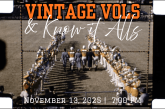In the process of visiting different boxing gyms around Appalachian and getting to know the people who frequent them, local filmmaker Curren Sheldon met Corky and Melvin, two of the main personalities that inform his new documentary “Country Brawlers.” Even without realizing the specifics then, Sheldon knew they offered a story that he wanted to tell. Exciting, intimate, gritty and artfully crafted, the result presented a new perspective into a region whose narrative is dominated by struggle and crisis, and Sheldon executed his vision with tenderness and skill. Screening before a rapt audience at Film Fest Knox in November 2023, the rough edit earned the jury prize for Made in Tennessee documentary.
While work continues on “Country Brawlers,” you can view some of Sheldon and his wife’s (Elaine, director of last year’s “King Coal”) other credits on streaming services and on PBS’s “POV,” the longest-running nonfiction series on television. And while you can learn more about the filmmaker at his website, currensheldon.com, I caught up with him recently to discuss his latest project.
BLANK Newspaper: Tell me how you got into the world of Appalachian boxing.
Curren Sheldon: We’d just finished two films on the opioid crisis and sold them to Netflix, and I’d treated myself to a nice camera. Gritty sports and DIY boxing gyms seemed like cool things. And boxing was something that wasn’t so dark and heavy. I just needed to go out and shoot sports for a while.
BN: This film is raw and intimate; how did you get so close to the action and so personally close with the boxers and their community?
CS: All the documentary work that we do, whether it’s going out alone or as a team, we “show up.” Being a small independent team, you can be nimble and spend as much time as you need to. Whereas when you’re a 15-person crew, you’re spending thousands of dollars a day to employ and feed and house everyone. You have limited time to meet the people you’re filming and forge relationships. When you’re one person, you have all the time you need.
A lot of the intimacy of the film came from the fact that these folks knew us well. We’d show up and talk to them for hours without cameras. It’s not about coming in with direction and capturing what you want to see. It’s being consistent, doing what you say you’re going to do and putting in the effort to show up. Filmmakers can get too focused on, “I want to make a good movie” when the real magic is in being good to the people you’re filming, and out of that emerges a great movie.
We do a lot of observational veritae filming, which means we’re not telling anyone what to do, just observing. We become the lamp in the corner. Once you’re there enough, people become comfortable with your presence. And when it’s just one or two people, it’s much easier to get comfortable.
On larger sets, there’s a full crew and sometimes three to four producers in the other room listening to everything that’s filmed. It’s a lot harder to feel comfortable being vulnerable when you feel like you’re on display. The smaller you can be as a team, the more access you get to vulnerable moments.
BN: It’s hard to wrap my head around the fact that this was such a small team making this film. Your wife Elaine helped with some of it, but much of the process was solitary. Can you walk me through some of the technical feats of this project?
CS: We always made sure there was a second person for the fights, but the one-man-band stuff comes down to being able to run audio and cover a scene with your camera. When you have three to four characters in a scene, the best you can do is to mic up whoever you can and have a shotgun mic attached to the camera.
The intimacy and vulnerability are also influenced by rarely having an additional person to run the audio, meaning that if the lavalier mics became scratchy or the sound was unusable, the shotgun mic was the only backup. So I had to get close.
BN: You moved from the Midwest to West Virginia as a child, and Elaine has multiple generations rooted in the region. Your films are largely set in and inspired by Central Appalachia. What keeps this area so close to your heart and art?
CS: She’s the one who inspired me. Elaine has always wanted to change the narrative of the way people see the Central Appalachia region. Since the war on poverty, America has seen West Virginia and Central Appalachia through a depressing lens. But the reality is [that] everyone has a story to tell. So we try to tell those stories with dignity and respect.
Our films are more about, “Who is trying to help the situation? What is the positive entry point to these pervasive struggles?”
It was an interesting avenue to approach the issues in Appalachia but through the lens of sport. We have characters who have overcome addiction or who might be struggling financially. But with “Country Brawlers,” you come for the entertainment, and you stay for the deeper meaning of the film.
amelia@blanknews.com







